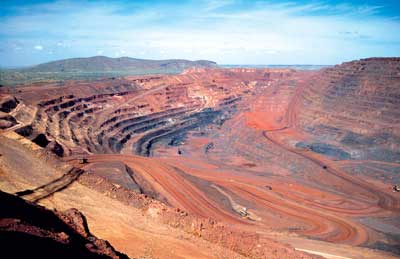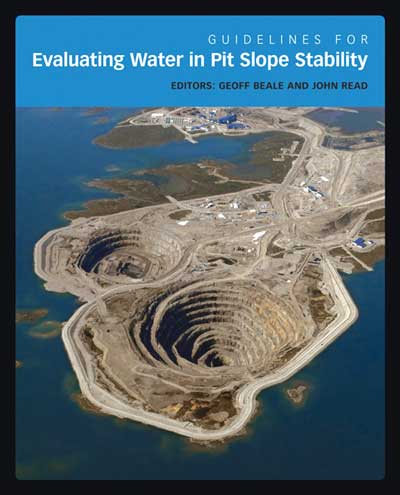WHAT BEGAN AS AN INTERNATIONAL RESEARCH AND TECHNOLOGY TRANSFER PROJECT HAS CHANGED THE WAY THE MINING INDUSTRY APPROACHES OPEN-PIT DESIGN.
 |
| Risk management is a serious part of the business these days, says Dr. John Read, a CSIRO senior manager who leads the organization’s coordination of the industry-wide large open-pit mine slope stability project. Companies make huge investments in these mines and the mines are also huge. |
When CSIRO Senior Manager Dr. John Read brought together a group of industry contacts at a conference in Santiago, Chile, in 2004 to sound out the idea of pooling knowledge of open-pit mine stability, he was pleasantly surprised with the reaction.
The contacts, representing major mining houses, backed his idea, providing the genesis for what is now known as the large open-pit mine slope stability project.
“There was immediate support from the group for a shared and better understanding of the geological interactions associated with rock mass failure and recognition of the need for new guidelines for reliable slope design,” Dr. Read said.
The project addresses an industry-wide need to improve understanding of the relationship between the strength and deformability of rock and the likely mechanisms of failure in large open-pit mines. It includes innovative geomechanics research, such as 3-D structural modeling, and is helping mine managers minimize the risk of loss of life, equipment damage and sustained production losses in the event of slope failure.
The project is coordinated by CSIRO and sponsored by 12 mining companies (see sidebar on page 50) representing much of the world’s base metals and diamond production. CSIRO is Australia’s national science agency. Sponsor companies are Barrick Gold, BHP Billiton Innovation Pty. Ltd., Codelco, Compania Minera Dona Ines de Collahuasi SCM, DeBeers Group Services, Newcrest Mining Ltd., Newmont Australia Ltd., Glencore Queensland Ltd., Debswana Diamond Co., and Rio Tinto.
By the end of this year, CSIRO and its partners will have produced four books to guide professionals such as geotechnical, mining, and civil engineers and hydrogeologists in the investigation, design and construction of stable rock slopes.
Chapters are written by the people regarded as having the most expertise in each area—often from the sponsor companies.
The first book, Guidelines for Open Pit Slope Design (2009), links project research with best practice in open-pit data collection and management; slope design, management and monitoring; and mining and risk management.
“The book outlines how you collect reliable data, prepare a geotechnical model, use data for stability analysis, apply that in mine development, and monitor the performance of the mine slopes,” Read said. “Failures will always happen, but what we’re trying to do is help manage the risk and diminish the likelihood of having a major failure.
“Companies can do this by having better design and monitoring practices to keep an eye on what’s going on, especially with slope management and the development of pore water pressure within the rock mass.”
The sponsor companies each provided $100,000 a year for the research, publishing and project coordination. Dr. Marc Ruest, De Beers Global Mining’s group lead of geotechnical and hydrogeology, said the project has been a long-term commitment that has been extraordinarily collaborative.
“De Beers has benefited significantly from the large open-pit project in so many ways. CSIRO has effectively brought together engineers from mining houses around the world to develop a common ground in the critical geotechnical design and implementation issues at our mine,” Dr. Ruest said. “The guidelines developed as part of the project continue to provide our practitioners with a high-quality baseline for the geotechnical programs at our operations.”
Read said the guidelines have helped mine managers become more aware of the need for reliable data and how to assess that data. It has also improved their understanding and assessment of rock mass strength and how to use that information to better analyze rock stability. This has helped them maximize safety, ore recovery and financial returns over the life of the mine.
“Risk management is a serious part of the business these days,” Read said. “Companies make huge investments in these mines and the mines are also huge. Some of the pits are up to 1,000 m deep—Chuquicamata in Chile for example, and some of the walls will be up to 1,400 m high, such as at Pelambres, also in Chile.”
The book is widely used. “You can find it on the desks of the geotechnical people at pretty much every mine site you care to go and visit,” Read said.
A second book, on open-pit design and water, was published early this year, expanding on a chapter in the original guidelines (see sidebar). Read said it provides mine managers with improved information on assessment and monitoring of pore water pressure in closely jointed rock, and how to incorporate this information into stability analyses. The first two books area available in hard copy and e-format from CSIRO Publishing (www.publish.csiro.au).
A third book, Guidelines for Open Pit Design in Weak Rocks, and a fourth, Geotechnical Guidelines for Mine Waste Dump and Stockpile Design, will be released later this year.
At a meeting in Brisbane last September, the sponsor companies decided unanimously to continue the project in some form, even though it is due to be completed in June, when Read’s own involvement in the project will end.
This article originally appeared in Resourceful, CSIRO’s magazine covering the minerals value chain.
A Guide to Best Practices for Hydrogeological Investigations Related to Slope Stability
 CSIRO said Guidelines for Evaluating Water in Pit Slope Stability offers slope design practitioners “a road map that will help them decide how to investigate and treat water pressures in pit slopes. It provides guidance and essential information for mining and civil engineers, geotechnical engineers, engineering geologists, and hydrogeologists involved in the investigation, design and construction of stable rock slopes.”
CSIRO said Guidelines for Evaluating Water in Pit Slope Stability offers slope design practitioners “a road map that will help them decide how to investigate and treat water pressures in pit slopes. It provides guidance and essential information for mining and civil engineers, geotechnical engineers, engineering geologists, and hydrogeologists involved in the investigation, design and construction of stable rock slopes.”
The publisher’s description of Guidelines for Evaluating Water in Pit Slope Stability refers to the book as “a comprehensive account of the hydrogeological procedures that should be followed when performing open-pit slope stability design studies…this book expands on the hydrogeological model chapter in the LOP project’s previous book Guidelines for Open Pit Slope Design.”
The book comprises six sections, which outline the latest technology and best practice procedures for hydrogeological investigations. The sections cover the framework used to assess the effect of water in slope stability; how water pressures are measured and tested in the field; how a conceptual hydrogeological model is prepared; how water pressures are modeled numerically; how slope depressurization systems are implemented; and how the performance of a slope depressurization program is monitored and reconciled with the design.









